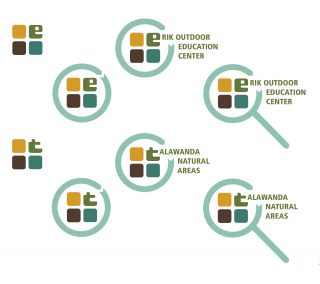Design Sophomores Maria Bee and Colleen Griffiths Create a Wayfinding System for Talawanda Natural Areas

During spring semester 2012, Miami graphic design sophomores Maria Bee and Colleen Griffiths worked in tandem with the Erik Sustainability Initiative (ESI) to create wayfinding signage for the Talawanda High School Natural Areas. Here they share their experiences:
=========
The new Talawanda High School building is situated on 147 acres of unused, undisturbed land comprised of wetland, prairie, deciduous forest, and agricultural habitats. Science Instructional Leader for the Talawanda School District and ESI President, Jeff Winslow, sent out a request to Miami Architecture, Graphic Design, and IES students to transform the unused land behind the new school building into an Outdoor Education Center. The goal of the project was to design a space that would engage Talawanda students and the Oxford community in life-long learning. The theoretical design would then be shared with potential donors in an effort to gain funding for the development of the outdoor land.
 For our independent study, we created a trail map, wayfinding signage, symbol system, and brand identity in order to engage the Talawanda community in hands-on learning and site exploration. We researched renowned wayfinding and signage systems and walked the outdoor trail behind Talawanda High School. This informed our design aesthetic and enabled us to understand the correlation between specific points on the trail map. We also interviewed teachers from Bogen, Kramer, and Talawanda schools in order to learn about their future vision for the Outdoor Education Center. The teachers’ commentary was extremely helpful–it enabled us to revise the logo and icon webs so that it better reflected the needs of the community.
For our independent study, we created a trail map, wayfinding signage, symbol system, and brand identity in order to engage the Talawanda community in hands-on learning and site exploration. We researched renowned wayfinding and signage systems and walked the outdoor trail behind Talawanda High School. This informed our design aesthetic and enabled us to understand the correlation between specific points on the trail map. We also interviewed teachers from Bogen, Kramer, and Talawanda schools in order to learn about their future vision for the Outdoor Education Center. The teachers’ commentary was extremely helpful–it enabled us to revise the logo and icon webs so that it better reflected the needs of the community.
As a result of this project, we gained invaluable experience in graphic design: we learned how to collaborate with a multidisciplinary team of faculty, students, and community members as well as how to work within the constraints of a budget. The relationships we formed with the Talawanda teachers and community members informed our work: it enabled us to create a better design that was specific and relevant to the students and community members involved. In addition, we practiced creating hierarchy through typography and increasing legibility through the use of a limited color palette. Most importantly, we learned how to design a unified, comprehensive brand identity that directly reflected the needs of our client.


